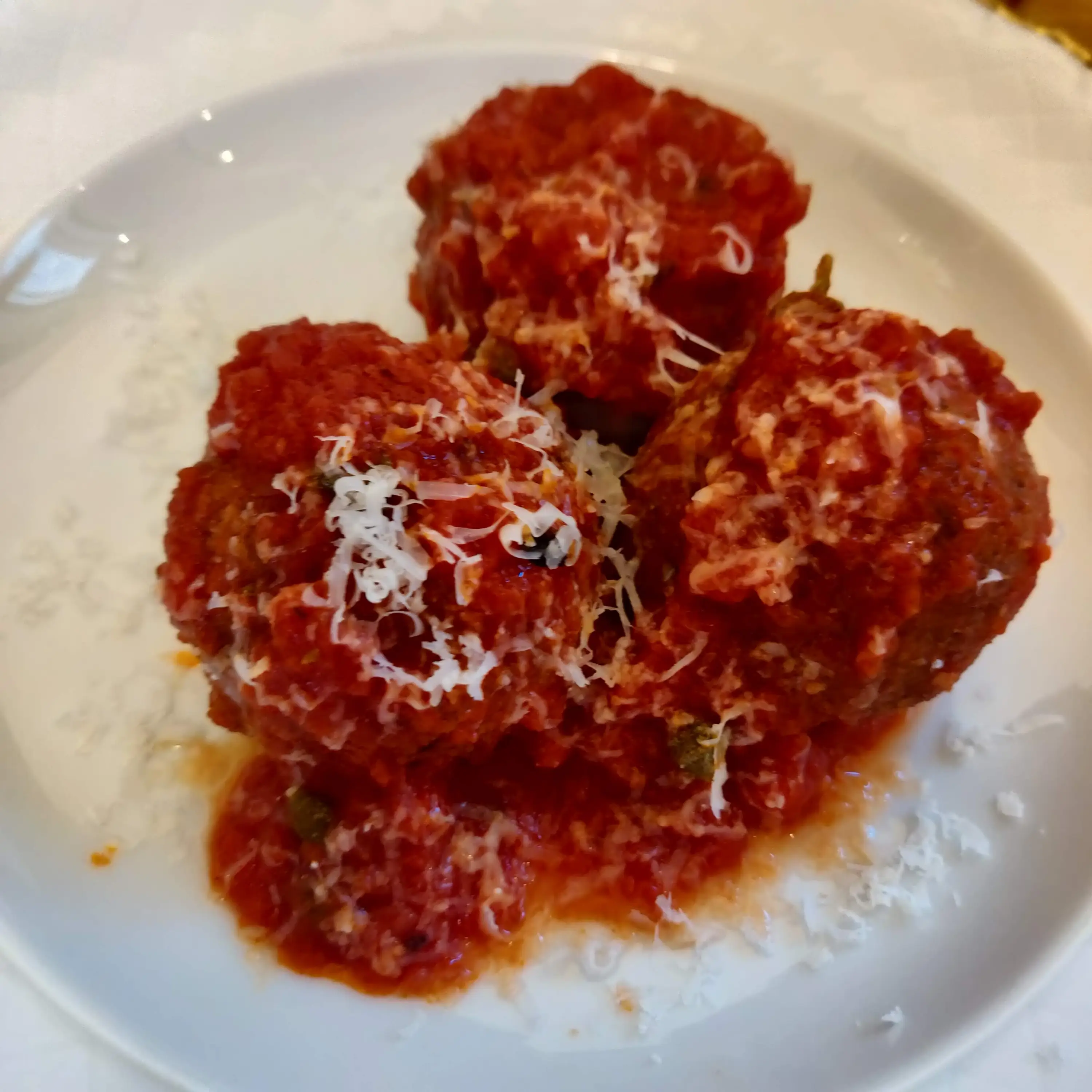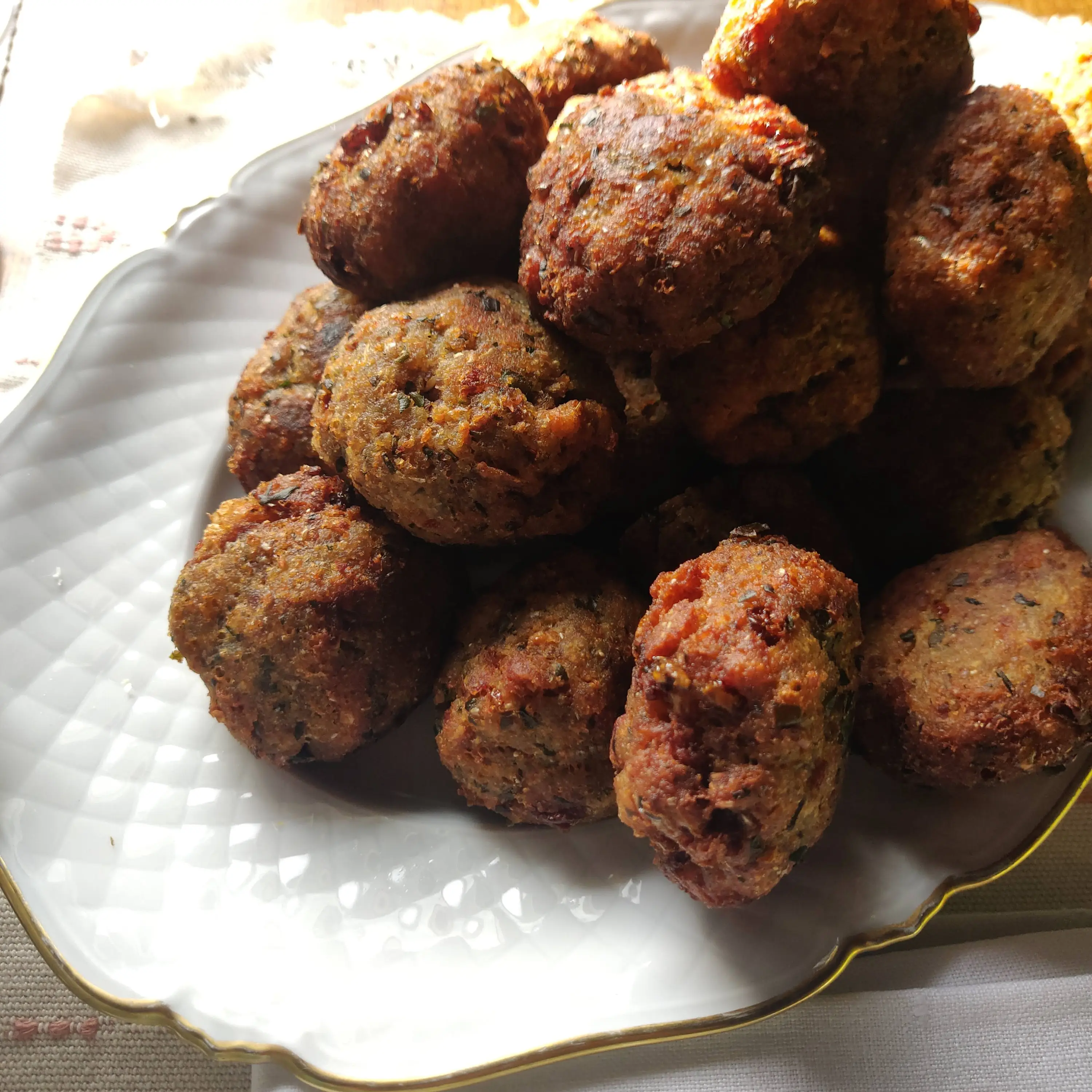











Lucca, June 2022 .
London, August 2022. This has been the best, most rewarding recipe of this summer. Just love it
I am a bread collector. All those stale loaf-ends (apparently called “the heels”) that cannot be eaten but cannot be turned into breadcrumbs either, I put aside – “I will make a bread pudding or a pancotto, an Italian bread soup”, I solemnly declare. P and Lucia roll their eyes, because they know their chickens: often these grand plans are not acted upon and, after weeks of ignoring it, I bin my bread, with a bad conscience.
This time, I looked at my collection of odd ends of bread and I decided to make polpette di pane, bread polpette and what an inspired decision that was. Over the last month I have cooked them a few times, actually buying and collecting bread with this purpose in mind.
They are made with leftover, rock-hard bread, briefly soaked in water, squeezed dry and crumbled. To this, I add chopped herbs, grated strong cheese and eggs. Then, as long as the final result can be shaped into polpette, anything can be added: chopped aubergines, grated courgettes, chopped spinach, all cooked first of course, then cubed cheese, chopped ham or mortadella.
I went first for a rather simple approach: chopped herbs, pecorino, a few capers and sun-dried tomatoes, and I stuffed them with a cube of Belpaese cheese. I have also made them both deep fried and poached (in tomato sauce) and they were always good. They can be eaten hot, at room temperature and even chilled, as I did on a scorching Italian summer day.
They seem to improve with age: make a big batch, keep in the fridge and eat them throughout the week. Here in Lucca, I use a sourdough loaf called “semi integrale”, fifty/fifty white and wholemeal flour but any sturdy, chewy bread would work. For best results, use rock-hard bread: there are fewer risks of having a pappy mix and a gummy polpetta.
For 4 to 6 portions
500 g hard bread, cut into cubes
A generous handful of chopped parsley with some mint
A couple of cloves of garlic, reduced to a paste with a little coarse salt
100 g grated pecorino Update 2024 I cut down the pecorino to 50 g and they were good too.
Two tablespoons capers, rinsed and chopped
10 sun-dried tomatoes halves, chopped with a couple of tablespoons of their oil (if they are not preserved in oil, add olive oil to the mix instead)
A couple of anchovy fillets preserved in oil, finely chopped
One or two eggs
About 100 g of soft melting cheese, such as Belpaese, to be cubed into as many pieces as there are bread balls Update 2024: I sometimes omit this
Update 2024: to boos umami, I have added a squirt of tomato paste (triple concentrate Mutti)
Vegetable oil, if you decide to fry them, or a cooked tomato sauce, not too thick.
Soak the bread in cold water. How long? You must be able to squeeze it then break it into crumbs, but beware that if you leave it too long, it will become water-clogged. Check it almost immediately, after just a few seconds. In some versions, milk is used instead of water, but I find this unnecessary. Squeeze the bread between your palms and crumble it as much as possible. You are aiming at a mix that is soft, crumbly but not mushy.
Add the herbs, garlic, cheese, capers, anchovies, sun-dried tomatoes and oil.
Mix well and add the first egg: mix again and decide if your mix is too dry and if you need the extra egg. If it is too wet and it is not possible to shape it, add some fine, dried breadcrumbs.
Check for salt and pepper.
Make polpette the size of a ping pong ball or of a small burger, stuffing the centre with the melting cheese. You can refrigerate them now and cook later.
Deep fry. Update 2024: as I have just bought an air fryer and I have been experimenting, I tried to cook them in it – delicious!! I brushed them with oil and roasted until firm and deep golden
They are delicious just fried but you could also simmer them in a tomato sauce, one that is not too thick and that is almost done: let the polpette simmer in the sauce for less than ten minutes.
You could also add them to the tomato sauce, without frying them in advance (again, no more than ten minutes simmering). Once, I had them with peas, cooked in the tomato sauce and the dish was spectacular.
I love all the flavors you add to the polpette — totally unexpected! definitely something we will want to try this winter. There’s such a comfort aspect to this dish. Hope you guys are well!
LikeLike
they are really special. we are fine thanks, off to Lucca soon. Are u coming to Italy?
LikeLike
Next time you’re about to bin dried out pieces of bread, turn them into breadcrumbs in a food processor. Not much better than store-bought, but more sustainable. I’ll have to try polpette di pane as I al curious what they are like.
LikeLike
Hi. I made these last week. I altered the recipe just a bit to suite what I had in my larder. But, wow they were delicious and we’ll definitely be having them again.
Thank you
LikeLiked by 1 person
Hi Bob, glad you tried them and liked them. I am right now drying up some bread because I want to make them again soon and I do not have enough leftover bread.
LikeLike
Unfortunately too often my bread is far to hard to be turned into breadcrumbs (to the point that I have baked a loaf yesterday to specifically turn into breadcrumbs, which is a useful to have in the fridge)
LikeLiked by 1 person
thanks, yes , of course you are right.. unfortunately I often let it slip and by the time I decide to make crumbs, the bread is far too hard for my magi mix – I am such a fool.
LikeLiked by 1 person
Wow!!! I love this! Who knew old bread loaf pieces could create this culinary delight.
Thanks for sharing.
Velva
LikeLike
Hi Velva. thanks – these are a nice way of using up old bread and they are incredibly tasty
LikeLike
You and I have a common hobby, I see. My freezer is half full of stale loaves. This is a nice way to start working my way through the over-supply… ! Anyway nice to see you back with another post after a rather long hiatus. Trust you’re well. You seem to have disappeared from Instagram, too… ?
LikeLike
Ciao Frank… thanks. when in Lucca (we now live between Lucca and London), I also made many panzanellas, sometimes with tomatoes, as they make it there, or, untraditionally, with other vegetables, for lovely, chilled, summer salads? Insta: trying to rethink the whole thing, but, no, I am still on it
LikeLike
Sounds delicious and another brilliant use for all those stale bits of bread.
Thank you
LikeLike
Do try it, you will be surprised how tasty they are and they improve with age, so to speak: I made a large batch and I had them over few days, and they got better
LikeLike
Brilliant! I hoard stale bread too – mostly for use in Spanish recipes like gazpacho and salmorejo, but also for croutons. Inevitably some ends up in the bin, but it’s good to have it handy. I will definitely try your Polpette di pane, which look delicious!
LikeLike
I wonder if Spanish cookery has something similar.
LikeLike
I have never had them, but they do exist. I should look into some recipes for them…
LikeLike
Fantastic idea & brilliant usage of leftover bread.
LikeLike
ciao Angela, they are incredibly good. give them a go
LikeLike